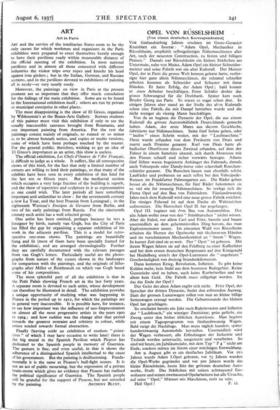ART
Art in Paris Aar and the service of the totalitarian States seem to be the only causes for which workmen and organisers in the Paris exhibition were prepared to exert themselves keenly enough to have their pavilions ready within measurable distance of the official opening of the exhibition. In most national pavilions and in almost all those connected with different industries the visitor trips over ropes and knocks his head against iron girders ; but in the Italian, German, and Russian sections, and in the pavilions devoted to exhibitions of painting all is ready—or very nearly ready.
Moreover, the paintings on view in Paris at the present moment are so important that they offer much consolation for the failings of the main exhibition. Some are to be found in the International exhibition itself ; others are run by private or municipal enterprise in other places.
The most disappointing is the show of El Greco, organised by Wildenstein's at the Beaux-Arts Gallery. Serious students of this painter must visit this exhibition if only to see the usually inaccessible canvases brought from Roumania, and one important painting from America. For the rest the paintings consist mainly of originals, so ruined or so minor as to be almost beneath notice, and copies or studio versions, some of which have been perhaps touched by the master. For the general public; therefore, wishing to get an idea of El Greco's importance as an artist, this show is useless.
The official exhibition, Les Chefs d'Oeuvre de l'Art Francais, is difficult to judge as a whole. It suffers, like all retrospective shows of this kind, for the fact that only a limited number of owners are willing to lend their paintings, so that many of the exhibits have been seen in every exhibition of this kind for the last ten or fifteen years. But the mediaeval section which occupies a very large fraction of the building is superb, and the show of tapestries and sculpture in it as representative as one could wish. The later periodd all have something important and unfamiliar to show : for the seventeenth century a new La Tour, and the best Poussin from Leningrad ; in the eighteenth Watteau's Enseigne de Gersaint from Berlin, and two of his early paintings from Russia. For the nineteenth century each artist has a well selected group.
One artist has been omitted, perhaps because he was a foreigner by birth, namely van Gogh, but the City of Paris has filled the gap by organising a separate exhibition of his work in the adjacent pavilion. This is a model for retro- spective one-man shows. The paintings are beautifully hung and lit (most of them have been specially framed for the exhibition), and are arranged chronologically. Further they are carefully documented with the relevant passages from van Gogh's letters. Particularly useful are the photo- graphs from nature of the scenes shown in the landscapes for comparison with the paintings, and the originals of litho- graphs after Millet or Rembrandt on which van Gogh based some of his compositions.
The most splendid part of all the exhibition is that in the Petit Palais showing French art in the last forty years. A separate room is devoted to each artist, whose development can therefore be illustrated in detail. The exhibition provides a unique opportunity of studying what was happening in France in the period up to 1912, for which the paintings are in general very inaccessible. It is possible here, for instance, to see how important was the influence of neo-Impressionism on almost all the most progressive artists in the years 1900 to 1904 ; and how sudden was the change after that period towards the greatest restraint and sobriety in colour, while
artists tended towards formal abstraction. -
Finally (leaving aside an exhibition of modern " primi- tives " of which I may have occasion to write later) there is the -big mural in the Spanish Pavilion which Picasso has dedicated to the Spanish people in memory of Guernica. The gesture is fine, and even useful, in that it shows the adherence of a distinguished Spanish intellectual to the cause of his government. But the painting is disillusioning. Funda- mentally it is the same as Picasso's bull-fight scenes. It is not an act of public mourning, but the expression of a private brain-storm which gives no evidence that Picasso has realised the political significance- of Guemica. The Spanish people will be grateful for the support of Picasso, but not consoled






































 Previous page
Previous page